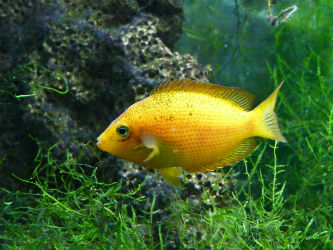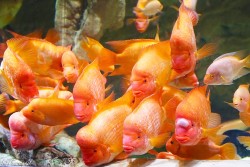Orange Chromide for Sale (Etroplus maculatus) endemic to freshwater and brackish streams India and Sri Lanka
 The Orange Chromide, scientifically known as Etroplus maculatus, is a captivating freshwater fish species that has gained popularity among aquarium enthusiasts for its vibrant colors, unique behavior, and adaptability to various aquatic environments. In this comprehensive guide, we will delve into the world of Orange Chromide, exploring its characteristics, care requirements, habitat, and more.
The Orange Chromide, scientifically known as Etroplus maculatus, is a captivating freshwater fish species that has gained popularity among aquarium enthusiasts for its vibrant colors, unique behavior, and adaptability to various aquatic environments. In this comprehensive guide, we will delve into the world of Orange Chromide, exploring its characteristics, care requirements, habitat, and more.1. Physical Characteristics:
- Coloration: As the name suggests, Orange Chromides are renowned for their stunning orange to reddish-brown body coloration, which can vary in intensity depending on their mood and environment. A series of vertical black bars adorn their sides.
- Size: These fish typically grow to an average length of 3 to 4 inches (7.5 to 10 cm), making them well-suited for smaller aquariums.
2. Habitat and Natural Range:
- Origin: Orange Chromides are native to the brackish waters and estuaries of the southwestern coast of India and Sri Lanka.
- Habitat: They inhabit a range of environments, including freshwater, brackish, and slightly saline waters with plenty of vegetation and hiding spots.
3. Behavior and Temperament:
- Orange Chromides are known for their peaceful temperament, making them suitable for community aquariums.
- They are sociable and often thrive when kept in small groups.
4. Diet:
- Orange Chromides are omnivorous and enjoy a varied diet. In captivity, they can be fed high-quality flakes, pellets, live or frozen foods like brine shrimp, daphnia, and small aquatic insects.
5. Tank Requirements:
- Tank Size: A minimum tank size of 20-30 gallons is recommended for a small group of Orange Chromides.
- Water Parameters: Maintain a temperature range of 75-82°F (24-28°C) and a pH level between 7.0 and 8.5. They tolerate slightly brackish conditions but can also thrive in freshwater setups.
6. Aquarium Setup:
- Provide ample hiding spots in the form of caves, driftwood, and plants. Orange Chromides appreciate a well-decorated tank with plenty of vegetation.
- Ensure good water circulation and a quality filtration system to maintain water quality.
7. Breeding:
- Orange Chromides are substrate spawners, meaning they lay their eggs on a flat surface. The parents usually guard the eggs and fry diligently.
- Breeding can be stimulated with an increase in water temperature and the introduction of small live foods.
8. Health and Care:
- Regular water changes, a balanced diet, and maintaining stable water parameters are essential for their well-being.
- Watch out for common aquarium diseases and treat promptly if necessary.
9. Compatibility:
- Orange Chromides are peaceful and can coexist with other non-aggressive fish species of similar size and temperament.
10. Conservation Status:
- Orange Chromides are not considered endangered, but their natural habitats are threatened due to habitat destruction and pollution.
In conclusion, the Orange Chromide is a captivating addition to any freshwater aquarium, appreciated for its striking colors and gentle demeanor. By providing them with a suitable environment and proper care, you can enjoy the beauty and charm of these unique fish while contributing to their conservation in their natural habitats.

Name: Orange Chromide
Other Names: Red Chromide, Pearl-spot, Spotted Etroplus
Scientific Name: Etroplus maculatus
Family: Cichlidae
Subfamily: Etroplinae
Distribution: India and Sri Lanka
Length: 3.5"
Water Temperature: 68 to 77 degrees Fahrenheit (20-25 degrees Celsius)
Diet: They thrive on fish fry, zooplanktonic foods and algae. Standard aquarium flake fare will be taken with relish as well. Color-enhancing foods, especially those high in carotene, are highly recommended.
Water Chemistry: dH between 9 and 19; some salt must be added to the aquarium or else these brackish fish will succumb to all sorts of anorexia- and fungus-related conditions. (7.5-11 tsp. salt/10 gallons recommended)
pH: 7-9
Lifespan: 5 years



